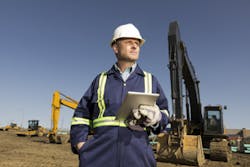In Part 1 of this series on Skid-Steer Wheels vs. Tracks the author continues to examine the debate.
The reason the track machine works better in sloppy conditions, explains Jim Hughes, brand-marketing manager for Case Construction Equipment Co., is that its weight is evenly dispersed over a larger area so that the ground pressure is lessened. In essence, it has a broader “wheel base” because it has more contact with the ground than a wheeled machine does. A CTL spreads its weight on the ground over the length and width of both tracks, while a skid-steer puts all its weight on the four wheels.
“The more track on the ground, the more stability you have,” Steger confirms. “[A CTL] is more stable than a wheeled machine. The track machine ‘floats’ over holes and bumps. It’s easier on the land and the operator.”
The Terex ASV CTL machines use more bogie wheels than other brands, which helps distribute the machine’s weight even better, contends Rick Harris, with Terex Construction. “As a result, you have lower ground pressure, more traction, and generally better performance. In fact, Terex ASV machines have the industry’s lowest ground pressure and exert one-tenth the pressure of skid-steer wheels.”
Terex is also the only compact track loader manufacturer to offer three different track options: general purpose tracks for the majority of conditions; smooth turf tracks for ultimate care and protection of sensitive surfaces like finished landscaping; and extreme-terrain tracks with aggressive treads and 10% more width for additional gripping action in snow, mud, or other extreme conditions.
Another benefit of being able to work in sloppy conditions is that the CTL can work more days. “In a calendar year, they work more because they can do a variety of jobs in wet conditions, rough terrain, soft ground, and on slopes,” Giorgianni says. “The skid-steer is not as versatile.” Steger adds that some landscapers use it for snow removal in the winter by attaching special snow tracks, blades, blowers, and buckets. “The key benefit is you can use it more days a year.”
But some would argue about where the CTL can be effectively used. “We used to say ‘not on asphalt,’” Steger recalls. However, he’s finding that many Takeuchi customers prefer the stability of a CTL when working on asphalt, despite the toll it takes on the tracks. Asphalt accelerates wear of the rubber track. The average life of a track is 750–800 hours, he estimates. Rental machines will get considerably less—roughly half that amount. However, “if you’re running primarily in dirt, you can get 1,000 hours.”
Typically, the CTL costs more to purchase and maintain. “Maintenance costs, especially if it’s used on pavement, are high,” Murphy reiterates. Pavement isn’t the only threat to the life of a track. Giorgianni points out that operators can wear out a track system by performing tight maneuvers. Harris recommends gradual turns. “Avoid making quick turns by counter-rotating. This will not only scuff turf and other sensitive surfaces, but can cause tracks to wear faster.”
Another way to quickly ruin a track is by not cleaning the undercarriage after usage. Mud and debris (rock, gravel, etc.) should be cleaned from the undercarriage daily. Track tension should be routinely checked to ensure optimal performance and long life. Beesley reminisces about early models that required pressure washing. Although those are largely gone, it still pays to keep them free of dirt and debris to avoid excess wear.
To further reduce wear, Komatsu designed a triple flange idler at the front. Most loaders have a single flange, Beesley explains. It’s a high-wear item because they run metal-to-metal on steel pins. Komatsu’s design puts the weight on the outside two flanges that ride on rubber. That reduces wear and provides a better ride. Customers get 1,500–2,000 hours out of the tracks, he says.
Once the track is worn or damaged, the whole thing has to be replaced, which can run anywhere from $1,100 to $2,000 and take up to 1.5 hours to do. “If you’re capable of using a wheeled machine,” Beesley advises, “it’s usually cheaper, in cost and maintenance. Tires are cheaper than tracks.”
While the skid-steer loader is less expensive to purchase than the compact track loader, the CTL is usually more cost effective, Harris counters. A typical compact track loader pays for itself in approximately 18 months through superior productivity and versatility. Basically, Giorgianni summarizes, “the choice depends on where you’re going to use the machine. But if money is no object, get the CTL. It offers more applications.”








